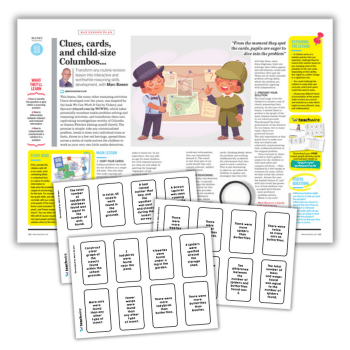Help Students Understand the Structure of Maths Problems Before Introducing Numbers

Give children the opportunity to develop a better understanding of the underlying structure of a problem by introducing numbers gradually, says Mike Askew…

- by Mike Askew
- Educator, researcher and speaker with a focus on primary maths education Visit website

Before reading on, I invite you to take a moment to think about the answer to this problem:
Sue and Julie are cycling equally fast around a track. Sue started first. When Sue had cycled nine laps, Julie had cycled three. When Julie completed 15 laps, how many laps had Sue cycled?
Got an answer? If it’s 45, then you probably reasoned along these lines: nine is three times three, so three times 15 is 45.
This answer would be correct if Sue was cycling three times faster than Julie, but she isn’t.
As the question states, Sue and Julie are cycling equally fast. Since Sue started first, she is six laps ahead of Julie.
Assuming they both manage to keep cycling at the same speed, then Sue will still be six laps ahead when Julie has done 15 laps, so the correct answer is 21.
Many people’s reaction to this problem, and ones like it, is, ‘That’s word problems for you, they are given to trip kids up.’
I think word problems can be valuable teaching and learning tasks, and the difficulty is not so much with this type of problem itself, but how they are commonly taught.
Typically, the contexts used in word problems are treated as window dressing – the important thing is to get down to figuring out what calculation to do.
Advice to pupils to look for and underline key words encourages them not to pay attention to the actual ‘story’ of the problem, but to strip away the context details and get down to plucking out a calculation.
This might not be too bad if the ‘key words’ method always worked, but it often doesn’t.
If, for example, ‘more’ means add, then why is 19 not the answer to this problem:
Nomsa has four more marbles than Busi. Nomsa has 15 marbles. How many marbles does Busi have?
It is easy to slip into thinking that the decision about what operation to do can be arrived at simply by looking at the numbers and what looks to be the relationships between them.
In the cycling problem we began with, the choice of three and nine and three and 15 is deliberate – pairs of numbers highly suggestive of a multiplicative relationship.
Imagine being told that Sue had cycled seven laps when Julie had cycled three, then being asked how many laps Sue had cycled when Julie had cycled eight.
The lack of any ‘nice’ ratios between the pairs of numbers would make you look more carefully at what the relationship is.
The key point is that there are two distinct steps we need to take when solving a word problem.
First we must work out the mathematical relationship between the quantities and, second, we must operate on the quantities.
The first step is totally independent of the actual size of the quantities. This is so important it is worth repeating: the relationship between quantities in a problem is independent of the size of the quantities.
Adults, as experienced problem solvers, immediately know the relationship between the quantities and we don’t recognise having gone through this first step.
In the cycling problem, the relationship between the quantities (number of laps) doesn’t even need to be worked out – the problem statement tells the reader right up front. But still it is tempting (and habitual) to cut straight to the numbers.
Focusing on relationships
So how do we help children reason about relationships, rather than rush to the numbers?
Key words don’t work, and I think advice like ‘understand the problem, really understand the problem’ is akin to talking more loudly when not being understood in a foreign country.
When recently coming across US maths teacher Brian Bushart’s excellent website, the (rather obvious) solution become clear: take the numbers out of a problem.
By working with what Bushart calls numberless word problems, children are given the opportunity to develop a better understanding of the underlying structures of problems before turning to any actual numbers.
Now, numberless word problems aren’t entirely without numbers, but the idea is that the numbers are introduced gradually, so that the class can, indeed has to, talk about the relations between quantities without knowing the actual quantities.
As specific numbers are gradually introduced, so the reasoning about what to do with those numbers emerges.
Let’s look at how a numberless word problem might be constructed and worked with.
Here’s a question adapted from one on the 2016 KS1 reasoning paper:
Abdul has nine shells. Amy has three more shells than Abdul. How many shells does Amy have?
The first step is to strip the question back to the core information, removing all numbers:
Step 1: Abdul has some shells. Amy has some shells.
Asking ‘What do you notice?’ and ‘What do you wonder?’ will prompt children to talk about how many shells Abdul and Amy each have and raise wonderings such as ‘I wonder if they have the same number of shells.’
Next, more information is added, but still no numbers:
Step 2: Abdul has some shells. Amy has more shells than Abdul.
Now we can ask the pupils what they notice now. What do we know now? What are some possible numbers of shells each could have?
Now the stage is set for a quantity:
Step 3 Abdul has nine shells. Amy has more shells than Abdul.
Children can now begin to talk about what they know about some of the possible number of shells Amy could have, and what number she cannot have.
Step 4: Abdul has nine shells. Amy has three more shells than Abdul.
Now it’s a short step not only to figuring out the question (how many shells does Amy have?), but also to arriving at an answer. But we don’t have to stop there.
One advantage of working up to the question in this way is being able to explore other possibilities.
We could go back to step 3 and reveal this instead:
Step 3: Abdul has nine shells. Amy has 12 shells.
What is the question to answer now?
Or we could go back to step 2 and reveal this:
Step 2: Abdul has some shells. Amy has three more shells than Abdul.
And from there reveal this:
Abdul has some shells. Amy has three more shells than Abdul. Amy has 12 shells.
What was a closed, rather dull, problem opens up a range of possibilities, and, more importantly, provides opportunities for talking about a range of mathematical structures.
Here are some further examples, broken down into the steps in which they would be revealed, all adapted from previous national tests.
KS1 numberless problems
How much money do they still need to collect?
How many friends are there?
How many cars did Mike start with?
How many balloons was Jo left with?










